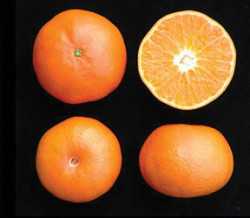
Twenty years ago, Florida produced tangerines on more than 50,000 acres of groveland. By 1998, this acreage had declined to roughly 26,000 acres. This acreage was primarily comprised of Honey, Sunburst, Fallglo, Dancy, and Robinson. Beginning around 2002, the Dancy and Robinson production declined to statistically insignificant volumes. Today, Florida produces tangerines on less than 15,000 acres, primarily represented by Honey, Sunburst, and Fallglo varieties. The decline in Florida tangerine acreage was partially attributable to freezes and disease, but is more significantly attributable to changing consumer preferences.
While the consumption of many fresh fruit and vegetables is declining, the consumption and sale of easy peel citrus, specifically high-quality tangerine and mandarin types, is on the rise. Low-seeded and seedless tangerines are an important part of the equation. Significant global acreage has been committed to this trend, much of which is only now coming into production. Despite large plantings in California and other production areas, Florida is well positioned to compete. Florida is the “local” supplier of fresh citrus to the entire Eastern Seaboard of the U.S. market. Florida remains a significant tangerine production state, but will have to adapt a new varietal portfolio to remain a significant player. Enter the US Early Pride tangerine.
Breeding Ground
The USDA-ARS citrus breeding program was the source of our Sunburst, Fallglo, Robinson, Osceola, Lee, and many other historically significant tangerines. US Early Pride is the latest USDA tangerine release and the first since 1987. US Early Pride is an induced mutation of Fallglo, with very low seed count and roughly the same maturity. Fallglo is a cross between Bower (tangerine X tangelo) and Temple (tangerine X orange) making it 5/8 tangerine, 1/4 orange, and 1/8 grapefruit. As a Fallglo mutation, US Early Pride shares this lineage.
According to Dr. Greg McCollum, the USDA-ARS researcher primarily responsible for the release, US Early Pride appears similar to Fallglo in all respects including fruit quality, yield, and flavor. Though much of US Early Pride fruit is totally seedless, the fruit is more properly positioned as a low-seeded tangerine, as the average seed count per fruit is less than two. Additional work is under way to determine whether US Early Pride will achieve good fruit set in a solid planting, without an inter-set pollenizer. The results of this work should be available soon.
Patent Pending
Researchers on Path To Make Apple Blossom Thinning Easier
New Varieties Development & Management Corp. (NVDMC) coordinated a multistate effort to request that US Early Pride be patented. A provisional patent has been issued for this variety and the full patent application was submitted by USDA-ARS last August. Once the patent is issued, US Early Pride will be the first patented USDA citrus scion variety. The process of licensing the variety will begin once the patent process is complete. Though the timeline for this process is uncertain, it is hoped all of this can be completed by spring 2012. NVDMC was asked to seek an exclusive license for US Early Pride on behalf of the four primary citrus producing states (Florida, California, Texas, and Arizona). Should NVDMC be awarded rights to US Early Pride, citrus growers in all citrus producing states would have equal access.
Presently, five Florida citrus nurseries are licensed to increase budwood of US Early Pride. Growers interested in planting trials of US Early Pride may do so by signing evaluation agreements with NVDMC (contact the author for more information). Nurseries interested in fresh varieties would be well served to begin increasing US Early Pride budwood. Once the license process is complete, demand is likely to be heavy. Plan ahead.
0 1 5 Take A Peek At US Early Pride Peter Chaires is the executive director of the New Varieties Development & Management Corp. See all author stories here.











